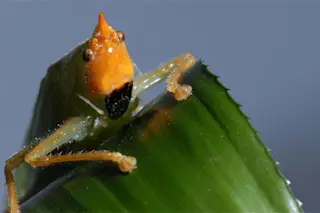Every time you put on some music or listen to a speaker’s words, you are party to a miracle of biology – the ability to hear. Sounds are just waves of pressure, cascading through sparse molecules of air. Your ears can not only detect these oscillations, but decode them to reveal a Bach sonata, a laughing friend, or a honking car.
This happens in three steps. First: capture. The sound waves pass through the bits of your ear you can actually see, and vibrate a membrane, stretched taut across your ear canal. This is the tympanum, or more evocatively, the eardrum. On the other side, the eardrum connects to three tiny well-named bones—the hammer, anvil and stirrup—which link the air-filled outer ear with the fluid-filled inner ear.
The bones perform the second-step: convert and amplify. They transmit all the pressure from the relatively wide eardrum into the much tinier tip of the stirrup, transforming large but faint air-borne vibrations into small but strong fluid-borne ones.
These vibrations enter the inner ear, which looks like a French whisk poking out of a snail shell. Ignore the whisk for now – the shell is the cochlea, a rolled-up tube that’s filled with fluid and lined with sensitive hair cells. These perform the third step: frequency analysis. Each cell responds to different frequencies, and are neatly aligned so that the low-frequency ones are at one end of the tube and the high-frequency ones at another. They’re like a reverse piano keyboard that senses rather than plays. The signals from these cells are passed to the auditory nerve and decoded in the brain. And voila – we hear something.
All mammal ears work in the same way: capture sound; convert and amplify; and analyse frequencies. But good adaptation are rarely wasted on just one part of the tree of life. Different branches often evolve similar solutions to life’s problems. And that’s why, in the rainforests of South America, a katydid—a relative of crickets—hears using the same three-step method that we use, but with ears that are found on its knees.
Grasshoppers, crickets and locusts all have knee-ears that, at just a fraction of a millimetre long, are among the tiniest ears in the animal kingdom. Even though countless numbers of these insects had been dissected, no one had really understood the structures of these ears.
Fernando Montealegre-Z from the University of Bristol has filled in the rest of the gaps. Fresh from recreating the sound of a Jurassic cricket, he turned to studying a katydid called Copiphora gorgonensis, a green insect with an orange face, topped with a unicorn-like spike and comical beady eyes.
He analysed the legs of living katydids using a CT scanner designed for tiny objects. The scans revealed a pair of eardrums (or tympanal membranes) on each knee. That much we already knew about. But Montealagre-Z also discovered two new organs.
The first– the acoustic vesicle (AV)—is like an uncoiled version of our cochlea, a tapering hollow fluid-filled tube. Other scientists had assumed that the AV was a simple blood vessel, but Montealegre-Z knew that couldn’t be right. For a start, it’s only found in the first pair of legs where the katydid’s ears are. It contains a line of sensitive cells called the crista acustica, like the hair cells that line our cochlea. Their role is the same – to analyse frequencies.
The AV is connected to each eardrum by a completely new structure called the tympanal plate (TP). It looks like just another part of the insect’s hard outer cuticle, but using lasers, Montealegre-Z found that it vibrates in time with the eardrum. This plate is the katydid’s version of our three ear bones – a stiff lever that converts the air-filled outer ear with the fluid-filled auditory vesicle. And just as our eardrums have 17 times more surface area than our stirrups, the katydid’s eardrum has 13 times more surface area than its tympanal plate. The effect is the same: large faint vibrations are converted into small strong ones.
So here’s how a katydid hears. Step one: the two eardrums captures sound, just as ours do. Step two: the tympanal plate sends these vibrations into the fluid-filled auditory vesicle, amplifying them in the process. Step three: the waves travel down the crista acustica, whose cells respond to the various frequencies and send that information to the insect’s nervous system. It’s the same set-up as in our own ears, but in structures that are a hundred times smaller.
Despite the similarities, there are obvious differences between the katydid’s ears and our own, besides the location, and the paired eardrums. Our cochleas hold between 17,000 and 24,000 hair cells, while the katydids only have 14 to 70. Those cells cover a range of frequencies between 10 and 50 kiloHertz. That spans around three very high-pitched octaves, and it’s much broader than the only sounds that katydids make to each other – a courtship note of around 18 to 23 kHz. Montealagre-Z thinks that the insects have evolved to hear other sounds beyond their own serenades – perhaps they high-frequency calls of hunting bats.
Reference: Montealegre-Z, Jonsson, Robson-Brown, Postles & Robert. 2012. Convergent Evolution Between Insect and Mammalian Audition. Science http://dx.doi.org/10.1126/science.1225271
Image by Daniel Robert and Fernando Montealegre-Z














